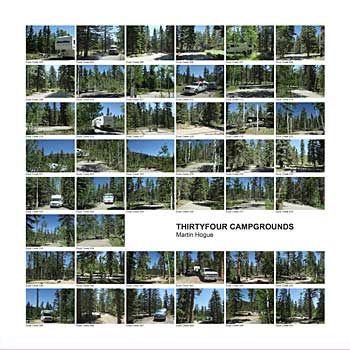
Thirtyfour Campgrounds examines the standardization and modernization of the contemporary campground as a familiar setting in the American landscape.
Campgrounds celebrate a unique form of American ingenuity in which intersecting narratives and desires (wilderness, individuality, access, speed, comfort, nostalgia, profit) find themselves strangely and powerfully hybridized. Thirtyfour Campgrounds traces the 150 year evolution of this unique landscape type. More broadly, however, the book poses important questions about the relationship between landscape and data: with a few clicks, taps or swipes, prospective campers now visit dozens of campgrounds and potentially hundreds of individual campsites in a single seating, comparing their advantages and disadvantages. How did we go from brave hikers setting up camp from scratch in the wilderness of the Adirondacks, to remotely browsing, shopping for, and reserving campsites in real time, often weeks or months in advance of arrival? How does the consumption of vast amounts of information through maps and websites shape our experience of campgrounds as landscapes? Are these landscapes themselves shaped by this information?
The book is a highly visual undertaking that features a combination of original drawings, archival materials and field documentation. The core of the book consists of a survey of color photographs of nearly 6,500 individual campsites retrieved from online reservation services like reserveamerica.com and recreation.gov. These photographs, arrayed into orderly girds and sequenced by zipcode and site number, span 200 pages. Taken together, these photos document 34 whole campgrounds of every stripe (federal, state, private) across the United States.
As a work of landscape and photography, Thirtyfour Campgrounds offers a nod to important artists who have expressed an interest for documenting similar generic settings: the title of the book is a direct reference to Ed Ruscha’s classic 1967 Thirtyfour Parking Lots (down to the idiosyncratic spelling of its title), which features aerial views of empty parking lots of all shapes and sizes in the Los Angeles area. The neutral, systematic arrangement of the thousands of campsite images in the book into grid form owes to German photographers Bernd and Hilla Becher’s typological studies of blast furnaces, cooling towers, grain elevators and other industrial structures, and whose work are staples of contemporary art collections.
More methodical in its approach than conventional campground literature, Thirtyfour Campgrounds calls the very nature of research, the survey and the inventory, into question.
There is a satisfying immediacy about the prospect of establishing an encampment for the night—clearing the site, erecting the tent, chopping wood, building a fire and cooking over the live flame—that in turn suggests a meaningful connection to landscape, place, and the rugged life of backwoods adventurers.
Each summer millions of Americans take to the road in search of this powerful experience of nature. Campgrounds all across the country commodify the locus of this singular experience into dozens, and often hundreds of individual sites. In Thirtyfour Campgrounds, I set out to explore some of these settings for myself. This is a book that was made so seriously that it must (not) be taken too seriously. For one thing, I did not personally visit any of the facilities, but sought to experience them from the standpoint of the camper/shopper, browsing online in preparation of her/his next camping trip. For another, the book is not a passion project: I am not much of a camper and don’t profess a great love for the outdoors. The project did however grow out of some of my own early camping experiences, and the profound disconnect I experienced between the ideal of being outdoors that many of us share when entering nature, and the physical realities of this unique spatial setting.
Modern campgrounds are indeed replete with delightful irony. Each “lone” campsite functions as a stage upon which cultural fantasies can be performed in full view of an audience of fellow campers interested in much the same “wilderness” experience. That parcel of land upon which most will elect to park their car, trailer, camper, or RV is thus not only an imagined ideal: there are currently over 900,000 campsites across the country, spread out over 20,000 campgrounds, most of which are designed according to a highly repetitive template centered around automobile accessibility. The small sample size in this book is representative of both the range of information that can be found online when reserving a campsite, as well as of all campgrounds nationally. All campsites end up looking much the same, which is both profoundly disturbing and quite funny at the same time. In many regards it’s fascinating that campers could make enlightened decisions about their encampment based on these photos. There are at once too many of them, and yet not enough to convey true meaning.
Thirtyfour Campgrounds is a large volume featuring an eye-popping 6,200 individual illustrations, most of them in color. The systematic arrangement of the campsite photographs in grids across the book (6,500 campsites, 48 per page) in ascending numerical order by site number lays bare the administrative foundation of these campgrounds, their coordinate systems of driving loops and addresses: Assateague Bayside 2.033; Cheney M+M Point 029; Watchman loop D, 007; Oh! Ridge 017, Bear loop. Missing campsite photographs are simply identified by blank spaces within the grids. To bring these campgrounds of all sizes and from all across the map into a coherent, linear sequence, the 34 facilities are arranged numerically by zipcode, from Seawall campground in Acadia National Park (04679) to Fort Stevens State Park campground (97121).
The reader may first find that no single page or section of the book stands out: indeed Thirtyfour Campgrounds can be entered from just about any page and read forward, or in reverse. A chartreuse-colored ribbon serves as a placeholder among the endless repetition of dull, impersonal photographs. Taken by anonymous staffers of varying skill, the role of each photograph is not to capture the broader context of the campground but to document the campsite as a piece of real estate—a generic setting of utilities.
But the repetition soon makes way for subtle differences. Textures of soil, shrubs, and foliage are revealed. Broad landscape features take shape in the background across consecutive photographs. Time reveals itself in fading light and passing clouds, the color of leaves, or the unexpected weather changes between photographs of neighboring sites.
By looking in between the exposures, as it were, a new reality begins to take shape.
Camping has long fascinated and engaged a broad number of scholars in the fields of American studies, tourism, cultural geography, historical preservation, and landscape architecture. However, there exists surprisingly little book-length, contemporary scholarship on the subject.
Interest in camping is timely: each summer millions of Americans take to the road in search of this powerful experience of nature, and the importance of online sources in facilitating this process has only grown in importance over the past few years. In 2010, Kampgrounds of America—KOA, familiarly—alone reported a total consumption of over five million campsite-nights, as well as 1.5 million hits monthly on its website. Demand at the country’s most scenic campgrounds has been so high that prospective campers can now reserve campsites up to 6 months in advance of their projected date of arrival. Some would-be campers are even turning to Craigslist to purchase campsite usage at areas like Yosemite National Park during busy holiday weekends, and this at three or four times their original price. At the same time, Walmart’s decision 15 years ago to open its parking lots nationally to overnighting RVers free of charge indicates a further and potentially radical devaluation of the traditional campsite. With its only goal being to attract new customers, Walmart’s decision created—overnight—a new campground network with thousands of informal facilities that could rival camping giants like KOA.
With its clear and accessible tone, as well as its unique combination of analytical drawings and historical materials, Thirtyfour Campgrounds contributes to the available literature on the emergence, standardization, and modernization of the American campground. And with its methodical documentation of 6,500 campsites, this is a highly visual book that promises to attract not only scholars and enthusiasts of the craft, but a broad audience of design and art professionals as well.


Martin Hogue teaches landscape architecture in the College of Environmental Science and Forestry at the State University of New York. His research explores the notion of site as a cultural construction. Hogue was trained as an architect and landscape architect, and he works primarily with analytical drawings as a mode of inquiry. Among the venues that have hosted his solo exhibits are the Urban Center in New York, Cornell University, the University of Southern California, Ohio State University, and the Center for Land Use Interpretation.